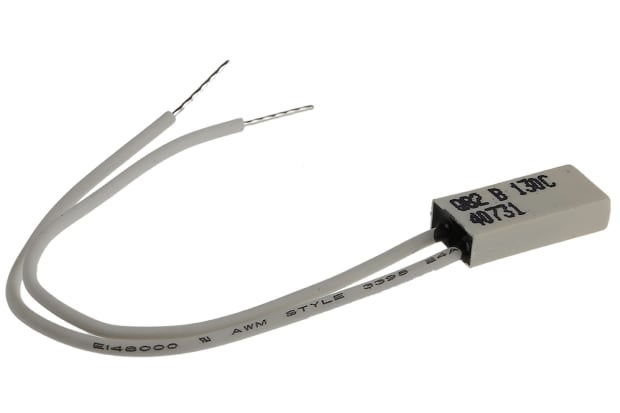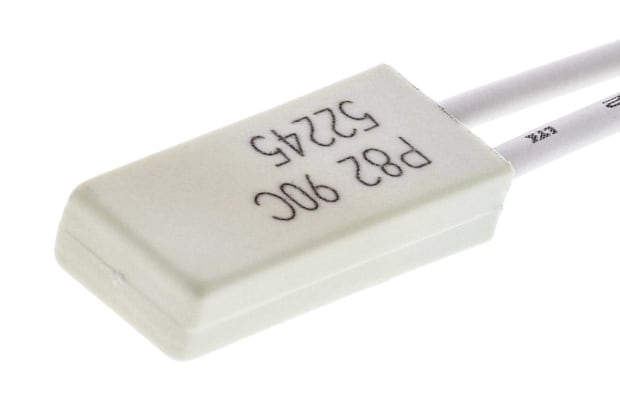- Published 29 Apr 2024
- Last Modified 26 Mar 2025
- 8 min
A Comprehensive Guide to Thermal Fuses
This comprehensive guide explores thermal fuses, including their functions, working principles, common types, applications and test procedures, providing valuable insights for your electrical projects.

Understanding Thermal Fuses
In the realm of electrical safety mechanisms, thermal fuses stand as crucial components, often overlooked but fundamental in preventing overheating disasters in various applications across New Zealand.
What is a Thermal Fuse?

Thermal fuses, also known as thermal cutoffs or thermal links, are small, heat-sensitive devices integrated into electrical circuits. In New Zealand, these essential components play a crucial role in ensuring electrical safety by preventing overheating disasters. Their primary function is to interrupt the electrical flow when the temperature exceeds a predetermined threshold, safeguarding against potential fire hazards or equipment damage due to overheating.
Unlike thermocouples, which measure temperature and generate a voltage signal, thermal fuses act as one-time safety devices that permanently break the circuit when a specific temperature is reached.
Thermal fuses are designed with a fusible alloy or a non-resettable, thermally sensitive conductor, strategically placed within the circuit. Once the temperature surpasses the set limit, the fusible material melts or the conductor irreversibly breaks, creating an open circuit and halting the current flow.
Unlike traditional fuses or circuit breakers, thermal fuses do not respond to current surges or short circuits. Instead, they solely rely on temperature variations to trigger their protective action. This makes them ideal for applications where overheating is the primary concern, such as in appliances, electronics, and industrial equipment.
What is the Function of Thermal Fuses, and Why is it Important?

In various electrical appliances and industrial machinery, thermal fuses serve as indispensable guardians against catastrophic thermal events. They are particularly prevalent in devices where excessive heat buildup could lead to ignition or cause critical components to fail.
Some examples include:
- Hair dryers
- Coffee makers
- Electric motors
- Transformers.
By swiftly responding to temperature anomalies, thermal fuses mitigate the risks associated with overheating, enhancing both safety and reliability in diverse applications. This is important across many areas of New Zealand, where ensuring the longevity and safe operation of electrical equipment is essential.
Understanding how thermal fuses work is essential for ensuring their effective integration into electrical systems, thereby minimising the potential for thermal-related accidents or equipment malfunctions. By correctly incorporating thermal fuses into your designs, you can enhance the safety and reliability of your electrical systems.
How do Thermal Fuses Work?
Understanding how thermal fuses work unveils their pivotal role in electrical safety. Delving into their operation elucidates the mechanisms behind their ability to safeguard against overheating.
Principle of Operation
At the core of a thermal fuse lies a temperature-sensitive element, typically made of a fusible alloy or a conductive material with a low melting point. This element is strategically positioned within the electrical circuit, in close proximity to the components prone to overheating. This design ensures that the thermal fuse accurately reflects the temperature of the critical components it is meant to protect.
Temperature Sensing
As the electrical device operates, generating heat, the temperature around the thermal fuse gradually rises. When the temperature surpasses the predetermined threshold — often referred to as the "trip point" — the temperature-sensitive element undergoes a phase change. In the case of a fusible alloy, it melts, or in the case of a conductive material, it breaks. This irreversible change in the element's state is what triggers the protective action of the thermal fuse.
Disconnection
Upon reaching the trip point, the change in the state of the temperature-sensitive element triggers a mechanical action within the thermal fuse. This action typically involves breaking the electrical circuit, effectively interrupting the flow of current. By halting the current flow, the thermal fuse prevents further heating and mitigates the risk of fire or damage to the device.
Non-Resettable Protection
Unlike conventional fuses or circuit breakers, thermal fuses operate on a one-time basis. Once triggered, they remain permanently disconnected and must be replaced to restore the circuit's functionality. This non-resettable nature ensures that the protective action is maintained even after the temperature returns to safe levels. This feature is crucial for preventing the continued use of a potentially faulty device, which could lead to further damage or safety hazards.
What Causes a Thermal Fuse to Blow Out?
Understanding what causes a thermal fuse to blow is crucial for preventing damage to electrical appliances and ensuring safety. Several factors can lead to a thermal fuse exceeding its trip point and interrupting the circuit. These include:
- Overheating
- Old thermal fuse
- Manufacturing defect
- Excessive ambient temperature
What Should I Do if the Thermal Fuse Keeps Blowing?
If you find yourself repeatedly replacing thermal fuses, it's crucial to investigate what the root cause of the problem is. While replacing a blown thermal fuse is a common solution, frequent failures are the tell of an underlying issue with the appliance or equipment. This could be due to overheating, a malfunctioning component, or other electrical faults.
Here are some steps on how you can address a recurring thermal fuse problem:
- For Dryers: Clean the lint trap, ducts, and the blower wheel to ensure proper airflow and prevent overheating. A clogged vent or restricted airflow can cause the dryer to overheat, leading to a blown thermal fuse.
- For Ovens: Ensure cooling fans and vents are unobstructed to allow for adequate heat dissipation. Blocked vents can lead to excessive heat buildup and cause a blown thermal fuse.
- For HVAC Systems: Replace dirty filters and check the fan motor for proper operation. A dirty filter or a malfunctioning fan motor can restrict airflow and cause overheating, leading to thermal fuse failure.
- For Electrical Appliances: Check for loose wiring or burnt connectors, which can cause electrical faults and overheating. If you're unsure about how to check a thermal fuse or troubleshoot electrical issues, it's always best to consult a qualified technician.
Different Types of Thermal Fuses
Thermal fuses come in various designs and configurations, each tailored to suit specific applications and operating conditions. Understanding the different types of thermal fuses enables engineers, technicians, and DIY enthusiasts to select the most suitable option for their needs.
1. Radial Thermal Fuses
Radial thermal fuses feature a cylindrical design, with the temperature-sensitive element housed within a cylindrical or disc-shaped casing. This fuse is commonly used in appliances such as coffee makers, irons, and hair dryers, where space constraints may necessitate a compact form factor.
2. Axial Thermal Fuses
Axial thermal fuses, as the name suggests, have a linear or tubular shape, with the temperature-sensitive element positioned along the axis of the fuse. This design facilitates easy integration into circuit boards and wiring harnesses, making them ideal for applications in electronics and automotive industries.
3. Surface Mount Thermal Fuses
Surface mount thermal fuses are specifically designed for surface mounting on printed circuit boards (PCBs). They feature flat, rectangular bodies with solder terminals, allowing for straightforward assembly onto PCBs during manufacturing processes. These fuses are widely used in consumer electronics, telecommunications, and industrial control systems.
4. Encapsulated Thermal Fuses
Encapsulated thermal fuses are hermetically sealed within a protective casing, providing enhanced durability and resistance to environmental factors such as moisture, dust, and vibration. This design makes them suitable for harsh operating conditions encountered in automotive, aerospace, and marine applications.
5. Organic Thermal Fuses
Organic thermal fuses utilise organic materials as the temperature-sensitive element, offering advantages such as faster response times and higher reliability compared to traditional metallic fuses. They find applications in high-performance electronics, where precise temperature control and rapid thermal protection are paramount.
Common Applications for Thermal Fuses
Thermal fuses find widespread use in a multitude of industries and applications where temperature control and safety are paramount considerations. Their reliable operation and ability to prevent overheating make them indispensable components in various devices and equipment. Let's explore some of the common applications where thermal fuses are extensively employed:
1. Home Appliances
Thermal fuses are commonly integrated into household appliances such as coffee makers, toasters, electric kettles, and microwave ovens to prevent overheating and to mitigate the risk of fire.
2. HVAC Systems
Heating, Ventilation, and Air Conditioning (HVAC) systems utilise thermal fuses to protect against excessive temperatures in components like heating elements, motors, and control circuits, ensuring safe and efficient operation.
3. Automotive Industry
In automotive applications, thermal fuses are used in various components including seat heaters, cooling fans, and ignition systems to prevent electrical malfunctions and reduce the risk of vehicle fires.
4. Power Tools
Power tools such as drills, saws, and grinders incorporate thermal fuses to safeguard against motor overheating, prolonging the lifespan of the equipment and enhancing user safety.
5. Industrial Machinery
Thermal fuses are essential in industrial machinery such as compressors, pumps, and manufacturing equipment, where overheating can lead to equipment downtime, production delays, and potential safety hazards.
Where is the Thermal Fuse in Appliances?
Typically, you can find the thermal fuse near heat-generating components, such as the heating element, motor, or power supply. This strategic placement allows the thermal fuse to directly monitor the temperature of these critical components and quickly interrupt the circuit in case of overheating.